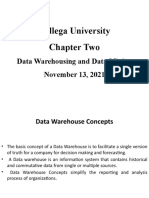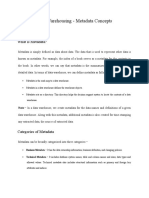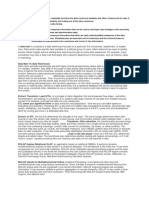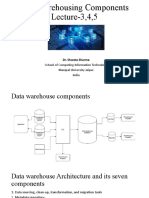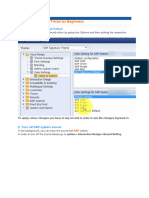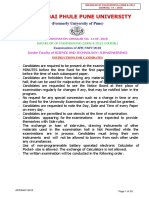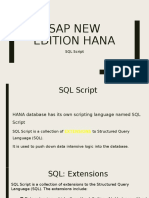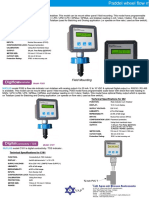0 ratings0% found this document useful (0 votes)
26 views25 pagesData Mining
Uploaded by
SAYAN MUSICCopyright
© © All Rights Reserved
We take content rights seriously. If you suspect this is your content, claim it here.
Available Formats
Download as PDF, TXT or read online on Scribd
0 ratings0% found this document useful (0 votes)
26 views25 pagesData Mining
Uploaded by
SAYAN MUSICCopyright
© © All Rights Reserved
We take content rights seriously. If you suspect this is your content, claim it here.
Available Formats
Download as PDF, TXT or read online on Scribd
You are on page 1/ 25
❖ Define Data Warehouse?
A data warehouse is a sophisticated and scalable enterprise-level
solution that serves as a powerful and unified hub for collecting,
organizing, and analyzing vast amounts of data from disparate sources.
By employing advanced ETL processes, data warehouses seamlessly
integrate diverse data types and formats, ensuring data consistency
and accuracy. These repositories are meticulously designed to support
complex analytical queries, data mining, and predictive modeling,
empowering organizations to derive actionable insights, identify
trends, and make informed strategic decisions.
❖ Explain the different data warehouse model?
Dimensional Model: The dimensional model organizes data into two
main components: dimensions and facts. Dimensions represent the
business entities or attributes by which data is analyzed, such as time,
location, product, or customer. Facts contain the numerical or
quantitative measurements or metrics, such as sales revenue or
quantity sold. This model is optimized for query performance and is
well-suited for analytical reporting and ad-hoc analysis.
Normalized Model: The normalized model follows standard
normalization principles, aiming to eliminate data redundancy and
ensure data consistency. It structures data into multiple normalized
tables, minimizing data duplication. This model is efficient for data
transaction processing systems, as it reduces data anomalies and
supports data integrity.
Hybrid Model: The hybrid model combines elements of both the
dimensional and normalized models to strike a balance between query
performance and data integrity. It leverages the dimensional model for
analytical reporting and the normalized model for maintaining data
consistency and integrity. In this approach, some dimensions may be
denormalized to improve performance, while other tables remain
normalized to preserve data integrity. The hybrid model offers
flexibility and can be tailored to specific business requirements and
performance considerations.
❖ Define data mart ? What are the reason for creating data
mart ?
Data Mart Definition: A data mart is a specialized subset of a data
warehouse that is designed to serve the needs of a specific business
function, department, or user group within an organization. It contains
a targeted collection of data that is relevant to the specific analytical
and reporting requirements of that particular group.
Reasons for Creating Data Marts: a) Improved Performance: By
creating data marts, organizations can optimize query performance by
providing pre-aggregated and summarized data specifically tailored to
the needs of the user group. This focused and streamlined data allows
for faster and more efficient analysis and reporting. b) Enhanced
Business Focus: Data marts enable organizations to align data and
analytics with specific business areas or departments. By creating
dedicated data marts, decision-makers and analysts can have a more
comprehensive and detailed view of the data relevant to their specific
domain, resulting in more informed and targeted decision-making. c)
Simplified Data Access: Data marts provide a simplified and intuitive
interface for end-users, making it easier for them to access and
retrieve the relevant data. By tailoring the data structure and
organization to the specific needs of the user group, data marts offer
a user-friendly experience and enable self-service analytics. d)
Scalability and Agility: Data marts allow for scalable and agile
development. Organizations can incrementally create and expand data
marts as needed, focusing on the specific requirements of different
user groups or business functions. This flexibility enables faster
deployment and adaptation to changing business needs. Data marts
can enhance data governance and security by providing controlled
access to sensitive data. With dedicated data marts, organizations can
implement fine-grained access controls, ensuring that users only have
access to the data that is relevant to their roles and responsibilities.
❖ What are the need for a separate data warehouse?
Performance Optimization: Data warehouses are designed and
optimized for analytical processing, providing faster query
performance and efficient data aggregation. By separating the
operational workload from analytical queries, organizations can
ensure that reporting and analysis activities do not impact the
performance of transactional systems.
Data Integration: A data warehouse allows for the consolidation of
data from various sources, such as transactional databases, external
systems, spreadsheets, and more. This integration of data into a single
repository provides a unified view, eliminating data silos and enabling
comprehensive analysis across different data domains.
Historical and Time-Variant Analysis: Data warehouses retain
historical data, allowing users to analyze trends, patterns, and changes
over time.
Data Quality and Consistency: Data warehouses often include data
cleansing and transformation processes as part of the ETL pipeline.
This ensures that data is standardized, consistent, and reliable for
analysis.
Scalability and Flexibility: Data warehouses are designed to handle
large volumes of data and accommodate future growth. They provide
a scalable infrastructure that can support evolving data needs and
expanding analytical requirements without compromising
performance.
Business Intelligence and Reporting: Data warehouses serve as a
foundation for business intelligence (BI) activities, supporting
advanced reporting, data visualization, and ad-hoc analysis.
Regulatory Compliance: Separating operational and analytical data in
a data warehouse can aid in complying with regulatory requirements.
By maintaining a dedicated repository for reporting and analysis,
organizations can implement appropriate access controls.
❖ Define metadata? What are the application of metadata? List
out the type of metadata?
Metadata Definition: Metadata refers to descriptive information about
data. It provides context and details about the characteristics,
structure, and usage of data. Metadata describes the attributes,
relationships, and meaning of data, helping to understand, manage,
and use the data effectively.
Applications of Metadata: a) Data Discovery and Understanding:
Metadata enables users to discover and understand the data available
in a system or database. It provides information about data sources,
tables, columns, data types. b) Data Integration and Interoperability:
Metadata plays a crucial role in data integration initiatives. It helps in
mapping and aligning data elements across different systems. c) Data
Governance and Compliance: Metadata facilitates data governance by
providing information about data lineage, data quality, and data usage.
It assists in establishing data policies, enforcing data standards. d) Data
Management and Administration: Metadata supports data
management activities such as data modelling, data dictionary
maintenance, and data lifecycle management.
Types of Metadata: a)Technical Metadata: Technical metadata
describes the technical aspects of data, such as data formats, data
types, storage location, data source details.b) Business Metadata:
Business metadata provides information about the business context
and meaning of data. c) Operational Metadata: Operational metadata
captures information about the operational aspects of data, such as
data extraction, transformation, and loading processes (ETL).d)
Descriptive Metadata: Descriptive metadata describes the content
and characteristics of data. e) Structural Metadata: Structural
metadata defines the structure and organization of data. It includes
information about the database schema, table structures, column
definitions. f)Administrative Metadata: Administrative metadata
includes information about data ownership. g) Usage Metadata:
Usage metadata tracks the usage and history of data, including data
access patterns, data usage statistics, data lineage, and data
transformation history.
❖ Explain the various Schema of a data warehouse
Star Schema: The star schema is the simplest and most commonly
used schema design in a data warehouse. It consists of one central fact
table connected to multiple dimension tables. The fact table contains
the measurements or metrics of interest, such as sales revenue or
quantity sold, and is surrounded by dimension tables representing the
various attributes or dimensions related to the factsSnowflake
Schema: The snowflake schema extends the star schema by further
normalizing the dimension tables. In this design, the dimension tables
are divided into multiple levels of more granular tables. This
normalization is achieved by breaking down the dimension tables into
sub-dimensions, resulting in a structure that resembles a snowflake
when viewed graphically.
❖ What is data cube
A data cube, also known as a multidimensional cube or OLAP cube, is
a data structure used in online analytical processing (OLAP) that
organizes and stores data for multidimensional analysis. It extends the
concept of a two-dimensional table by adding dimensions, which
represent the attributes or categories by which data can be analyzed.
Measures, representing the metrics or data points of interest, are
associated with the dimensions. Data cubes enable efficient querying
and analysis of data along multiple dimensions, allowing users to
explore relationships and trends in a compact and organized manner.
❖ Explain OLAP operations in the multidimensional data
model
Slice: Select a specific subset of data by choosing values for one or
more dimensions. Dice: Select a subset of data by specifying values for
multiple dimensions simultaneously. Drill-down: Navigate from
summarized data to more detailed levels within a dimension. Roll-up:
Summarize or aggregate data from lower-level details to higher-level
summaries. Pivot (Rotate): Reorganize dimensions and measures to
view data from different perspectives. Drill-across: Analyze data
across multiple data cubes or dimensions. Ranking: Order data based
on measures or dimensions to identify top-performing entities.
Forecasting: Predict future trends and values based on historical data
and statistical techniques.
❖ What are the characteristics of data warehouse?
1. Subject-Oriented: Data warehouses focus on specific subject areas
or domains within an organization, such as sales, marketing, or
finance, providing a consolidated view of data related to these
subjects. 2. Integrated: Data warehouses integrate data from various
sources and systems, consolidating it into a unified format. 3. Time-
Variant: Data warehouses store historical data, allowing for trend
analysis and comparisons over different time periods. 4. Optimized for
Analytics: Data warehouses are designed for analytical processing,
providing efficient querying and analysis capabilities.5.High
Performance and Scalability: Data warehouses are built to handle
large volumes of data and support high-performance processing.
❖ Explain ETL process?
1. Extraction: The extraction phase involves retrieving data from
multiple sources, such as databases, files, spreadsheets, APIs, or
external systems. Data is extracted based on defined criteria, such as
specific tables, files, or time intervals. 2. Transformation: Once the
data is extracted, it undergoes a transformation phase where it is
cleaned, validated, and transformed to align with the data warehouse
schema. Data transformation involves various operations such as
filtering, sorting, aggregating, joining, and applying business rules or
calculations. 3. Loading: In the loading phase, the transformed data is
loaded into the data warehouse. This involves mapping the
transformed data to the appropriate tables and columns within the
data warehouse schema. The loading process may include processes
for inserting new data, updating existing data, or handling data
deduplication.
❖ What are the different types of data mart ?
1. Dependent Data Mart: Extracts relevant data directly from the data
warehouse for a specific business function or user group. 2.
Independent Data Mart: Created separately from the data
warehouse, using data from various sources, and designed for a
specific business function or department. 3. Virtual Data Mart:
Provides a virtual layer of abstraction on top of the data warehouse or
other data sources, presenting tailored views of data without
physically storing the data. 4. Hybrid Data Mart: Combines elements
of dependent and independent data marts, integrating data from both
the data warehouse and external sources. 5. Distributed Data Mart:
Data is physically distributed across multiple locations or systems, with
each location hosting a portion of the data mart. 6. Analytical
Sandbox: Provides a flexible environment for exploratory analysis and
experimentation with a subset of data.
❖ What is slice and dice ?
Slice: Slicing involves selecting a specific subset or "slice" of data from
a data cube based on the values of one or more dimensions. It allows
users to focus on a specific dimension or combination of dimensions
while disregarding other dimensions. For example, a user can slice
sales data to view sales performance for a specific product category or
a particular time period. Dice: Dicing involves selecting a subset of
data by specifying values for multiple dimensions simultaneously. It
allows users to further refine their analysis by creating a smaller, more
targeted subset of the data cube. Dicing is essentially a combination of
slicing and selecting specific values for additional dimensions. For
example, a user can dice sales data to analyze sales performance for a
specific product category in a particular region during a specific time
period.
❖ What do you mean by association rule learning?
Association rule learning, also known as association analysis, is a data
mining technique used to discover relationships and patterns in large
datasets. It identifies associations or correlations between items based
on their co-occurrence in transactions or events. By analyzing
transactional data, it generates association rules that indicate the
likelihood or strength of association between items.
❖ How does association rule learning work ?
Association rule learning works by analyzing transactional data to
discover patterns and associations between items. The process
involves calculating item frequencies, generating frequent itemsets,
and forming association rules. These rules indicate the likelihood of
certain items being associated based on their co-occurrence in
transactions. The generated rules are evaluated and selected based on
support, confidence, and other metrics. This technique helps
businesses gain insights into customer behavior, market trends, and
item relationships for decision-making.
❖ Explain the different types of association rule learning algo?
1. Apriori Algorithm: Classic algorithm that generates frequent
itemsets by iteratively pruning infrequent itemsets. It then extracts
association rules. 2. FP-growth Algorithm: Efficient algorithm that
constructs an FP-tree to represent frequent patterns and generates
itemsets and rules from it. 3. Eclat Algorithm: Mines frequent
itemsets using a depth-first search approach, exploiting vertical data
format for efficiency. 4. FPMax Algorithm: Extension of FP-growth
that focuses on mining maximal frequent itemsets efficiently. 5.
RuleGrowth Algorithm: Scalable algorithm that recursively partitions
data based on rule patterns and leverages compact data structures.
6. CAR (Classification based on Association Rules) Algorithm:
Combines association rule learning with classification to generate
rules used for classification purposes.
❖ What are the application of association rule learning?
1. Market Basket Analysis: Identifying co-purchased items for cross-
selling and upselling strategies in retail. 2. Recommender Systems:
Generating personalized recommendations based on item
associations. 3. Customer Behavior Analysis: Understanding
purchasing patterns and segmenting customers for targeted
marketing. 4. Fraud Detection: Detecting unusual patterns or
anomalies for fraud prevention. 5. Healthcare and Medical Research:
Analyzing patient data to identify risk factors and improve treatment
outcomes. 6. Web Usage Mining: Analyzing user browsing behavior
and enhancing content recommendations. 7. Supply Chain
Optimization: Optimizing inventory management and supplier
selection based on item associations.
1. Support: Support is a measure used in association rule learning to
determine the frequency of occurrence of an itemset in a dataset. It
represents the proportion of transactions that contain a specific
itemset. The support of an itemset A is calculated as the number of
transactions containing A divided by the total number of transactions
in the dataset. Higher support values indicate a stronger presence of
the itemset in the dataset.
2. Confidence: Confidence is a measure that assesses the reliability
or strength of an association rule. It represents the conditional
probability of finding the consequent item(s) given the antecedent
item(s). The confidence of a rule A → B is calculated as the support of
the combined itemset (A ∪ B) divided by the support of the
antecedent itemset (A).
3. Lift: Lift is a measure used to assess the significance of an
association rule beyond what would be expected by chance. It
compares the observed support of the rule to the expected support
under independence. Lift is calculated as the support of the
combined itemset (A ∪ B) divided by the product of the individual
supports of the antecedent (A) and consequent (B) itemsets. Lift
values greater than 1 indicate positive associations, values equal to 1
indicate independence, and values less than 1 indicate negative
associations or dependencies.
4. Apriori Tree: The term "Apriori Tree" seems to be a combination of
two concepts. The Apriori algorithm is an association rule learning
algorithm that generates frequent itemsets by iteratively pruning
infrequent itemsets. It plays a key role in association rule mining.
However, there is no specific "Apriori Tree" concept in association
rule learning.
5. Frequent Pattern: In association rule learning, a frequent pattern
refers to a combination of items that occurs frequently in a dataset. It
represents a set of items that frequently appear together in
transactions. Frequent patterns serve as the basis for generating
association rules. The identification of frequent patterns helps
uncover meaningful associations and itemsets that are statistically
significant and occur beyond random chance.
❖ Write down the apriori algorithm?
The Apriori algorithm is an association rule learning algorithm used to
find frequent itemsets in transactional data. Here's a shortened
version of the algorithm: 1. Initialize: Set a minimum support
threshold and an empty list of frequent itemsets. 2. Generate
Frequent 1-Itemsets: Count item occurrences and keep items meeting
the minimum support as frequent 1-itemsets. 3. Iterate: Join frequent
(k-1)-itemsets, prune infrequent candidates, count occurrences, and
keep frequent k-itemsets. 4. Generate Association Rules: Form rules
from frequent itemsets by creating antecedents and consequents. 5.
Evaluate Rules: Calculate measures like confidence and lift to assess
the significance and quality of the rules.
❖ Write down the FP growth algo
The FP-growth algorithm efficiently mines frequent itemsets from
transactional data. Here's a shortened version of the algorithm: 1.
Build the FP-tree: Construct a compact FP-tree to represent frequent
patterns and their support in the transactional data. 2. Create Header
Table: Generate a table that links to occurrences of each item in the
FP-tree for efficient traversal. 3. Mine the FP-tree: Recursively build
conditional FP-trees by extracting sub-trees for specific items and
removing infrequent items. 4. Extract Frequent Itemsets: Traverse
conditional FP-trees to collect frequent itemsets by combining items
with their frequencies. 5. Generate Association Rules: Form
association rules from frequent itemsets by creating antecedents and
consequents. 6. Evaluate Rule Measures: Assess rule significance and
quality using measures like confidence and lift.
❖ Advantage & disadvantage of FP growth algo
Advantages of the FP-growth algorithm: 1. Efficiency: The FP-growth
algorithm is highly efficient compared to other association rule
learning algorithms, such as Apriori. It avoids generating candidate
itemsets and utilizes the compact FP-tree structure, reducing the
number of database scans and improving performance. 2. Compact
Representation: The FP-tree structure allows for a compact
representation of frequent patterns in transactional data. It eliminates
the need to store the actual transactional database, resulting in
reduced memory requirements and faster processing. 3. Scalability:
The FP-growth algorithm is scalable and well-suited for mining large
datasets. It handles high-dimensional data and can efficiently mine
frequent itemsets even with a large number of transactions and items.
4. Flexibility: The FP-growth algorithm supports different types of
itemsets, including both single items and itemsets of varying lengths.
It can handle both binary and quantitative data, providing flexibility in
analyzing different types of transactional data.
Disadvantages of the FP-growth algorithm: 1. Initial FP-tree
Construction: Building the initial FP-tree requires an upfront scan of
the transactional data, which can be memory-intensive and time-
consuming for extremely large datasets. 2. Memory Usage: While the
FP-tree structure helps reduce memory requirements, it can still
consume significant memory space, particularly for datasets with
numerous unique items and long itemsets. 3. Lack of Incremental
Updates: The FP-growth algorithm does not readily support
incremental updates. If new data is added or existing data is modified,
the entire mining process needs to be re-executed from scratch. 4.
Limited to Single Machine: The FP-growth algorithm is typically
designed for single-machine implementations. Scaling it to distributed
or parallel computing environments may require additional
adaptations or techniques.
❖ What is unsupervised learning ? State the advantage and
disadvantage of unsupervised learning
Unsupervised learning is a type of machine learning where the
algorithm learns patterns, structures, or relationships from unlabeled
data without explicit guidance or labeled examples. The goal is to
discover inherent patterns or groupings within the data without prior
knowledge or predetermined outcomes. Advantages of unsupervised
learning in machine learning: 1. Pattern Discovery: Unsupervised
learning enables the discovery of hidden patterns, structures, and
relationships within unlabeled data that may not be easily identifiable
by humans. 2. Data Exploration: It allows for exploratory data analysis,
providing a holistic view of the data and uncovering insights that may
not have been anticipated. 3. Flexibility: Unsupervised learning is
applicable to various domains and datasets as it does not require
labeled examples. It can be used for a wide range of data types and
problem domains. 4. Cost-Effective: Unsupervised learning eliminates
the need for manual labeling of data, making it more cost-effective
compared to supervised learning methods that require labeled
training examples. Disadvantages of unsupervised learning in
machine learning: 1. Lack of Evaluation Metrics: Without labeled
data, it can be challenging to evaluate the performance and accuracy
of unsupervised learning algorithms objectively. 2. Subjectivity in
Interpretation: Unsupervised learning results can be subjective and
highly dependent on the analyst's interpretation, leading to potential
inconsistencies in the derived patterns or clusters. 3. Sensitivity to
Noisy Data: Unsupervised learning algorithms can be sensitive to noisy
or outlier data points, which can significantly impact the discovered
patterns or clusters and require careful preprocessing. 4. Lack of
Guidance for Decision-Making: Unlike supervised learning,
unsupervised learning does not provide explicit guidance or
predictions for specific outcomes, making it less suitable for direct
decision-making tasks.
❖ Define cluster
Clusters are groups of data points that share similar characteristics or
patterns. Clustering is an unsupervised learning technique that aims
to identify these groups without prior knowledge of class labels. It
helps reveal underlying structures and relationships in the data and is
used for tasks like customer segmentation, anomaly detection, and
pattern discovery. Clustering is based on similarity measures and
allows for exploratory data analysis.
❖ Classify various clustering methods
Clustering methods can be classified into different categories: 1.
Partition-based: Divide data into non-overlapping clusters (e.g., K-
means, K-medoids). 2. Hierarchical: Create a hierarchical structure of
clusters (e.g., Agglomerative, Divisive). 3. Density-based: Group data
based on density and identify dense regions as clusters (e.g., DBSCAN,
OPTICS). 4. Grid-based: Partition data space into a grid and assign
points to grid cells (e.g., STING, CLIQUE). 5. Model-based: Assume
data is generated from statistical models and find the best-fitting
model for each cluster (e.g., Gaussian Mixture Models, EM algorithm).
6. Subspace: Identify clusters in high-dimensional data subspaces
(e.g., CLIQUE, COBWEB).
❖ Define the centroid of cluster
The centroid of a cluster is a representative point at the center of the
cluster. It is computed as the average or mean of the feature values of
the data points within the cluster. The centroid serves as a reference
point for assigning data points to their respective clusters and is used
to characterize and interpret the properties of the cluster.
❖ What are outliers and different types of outliers
Outliers are data points that significantly deviate from the majority of
the data in a dataset. They are observations that are markedly
different from the normal or expected patterns, making them distinct
and separate from the rest of the data points. 1. Global Outliers: Data
points that deviate from the overall dataset. 2. Contextual Outliers:
Data points that are outliers only within a specific context or subset of
the data. 3. Collective Outliers: Groups or subsets of data points that
together form an outlier pattern. 4. Point Anomalies: Individual data
points that are significantly different from the majority. 5. Contextual
Anomalies: Data points that are outliers within a specific context but
are normal in another context.
❖ Define bagging and boosting
1.Bagging (Bootstrap Aggregating): It trains multiple models
independently on different subsets of the training data and combines
their predictions through majority voting or averaging. Bagging
reduces variance and improves model stability. 2. Boosting: It builds a
sequence of models iteratively, with each model focusing on the
instances that previous models struggled to predict correctly. Boosting
assigns weights to training instances and combines the models'
predictions to improve accuracy and handle difficult instances.
❖ Write downs the k means clustering algo
The K-means clustering algorithm is an unsupervised machine learning
technique used to partition a dataset into K clusters. Here is the step-
by-step process of the K-means algorithm: 1. Choose the number of
clusters (K) that you want to create. 2. Initialize K cluster centroids
randomly or based on a predefined method. 3. Assign each data point
to the nearest centroid based on the Euclidean distance or other
distance metrics. 4. Recalculate the centroids of each cluster by taking
the mean of the data points assigned to that cluster. 5. Repeat steps 3
and 4 until the centroids stabilize or a maximum number of iterations
is reached. 6. Output the final clustering, where each data point
belongs to a specific cluster based on the nearest centroid.
❖ Explain k- medoids clustering algo
The K-medoids clustering algorithm is a variation of the K-means
algorithm that uses medoids instead of centroids as the representative
points for each cluster. While the K-means algorithm uses the mean of
the data points as the centroid, K-medoids selects one of the actual
data points from the cluster as the medoid. 1. Choose the number of
clusters (K) that you want to create. 2. Initialize K medoids randomly
by selecting K data points from the dataset as initial medoid locations.
3. Assign each data point to the nearest medoid based on a chosen
distance metric (e.g., Euclidean distance). 4. For each cluster, evaluate
the total dissimilarity or distance between each data point and the
medoids within that cluster. 5. Swap a medoid with a non-medoid data
point from the same cluster, and compute the total dissimilarity for
the updated configuration. 6. Repeat step 5 for all possible swaps and
select the configuration that results in the lowest total dissimilarity. 7.
Repeat steps 3 to 6 until the medoids no longer change or a maximum
number of iterations is reached. 8. Output the final clustering result,
where each data point belongs to a specific cluster based on the
nearest medoid.
1) Hierarchical Clustering: Builds a hierarchy of clusters by merging
or dividing existing clusters. Offers flexibility in exploring clusters at
different levels of granularity. No predefined number of clusters
required.
2) Graph-based Clustering: Treats data points as nodes in a graph and
uses connectivity or similarity measures to determine clusters.
Effective for detecting non-linear structures and handling complex
data relationships.
3) Density-based Clustering: Identifies clusters based on the density
of data points. Finds regions of high density separated by areas of
lower density. Suitable for discovering clusters of arbitrary shape,
handling noise, and not requiring the number of clusters in advance.
❖ What is data mining?
Data mining is the process of extracting valuable insights and patterns
from large datasets using computational techniques. It involves
analyzing data to uncover hidden relationships, trends, and anomalies,
enabling organizations to make informed decisions and gain a
competitive advantage. Data mining encompasses various methods
such as association rule mining, classification, clustering, and anomaly
detection and finds applications in diverse domains.
❖ Application of data mining?
1. Customer Relationship Management (CRM): Data mining helps
analyze customer data to identify patterns and trends, enabling
personalized marketing, customer segmentation. 2. Fraud Detection:
Data mining techniques can detect fraudulent activities by analyzing
patterns and anomalies in transactional data, helping to identify
potential fraudsters . 3. Market Analysis and Forecasting: Data mining
enables businesses to analyze market trends, customer preferences,
and competitor behavior to make informed decisions, develop
effective marketing strategies, and forecast future market demand.
4.Healthcare and Medical Research: Data mining is used to analyze
large volumes of patient data, electronic health records.
❖ Types of Data Mining:
1. Association Rule Mining: Discovers relationships and associations
between variables in a dataset. 2. Classification: Assigns data points to
predefined classes based on their features. 3. Clustering: Groups
similar data points together based on their similarities or distances. 4.
Regression: Predicts numerical values or continuous outcomes based
on input features. 5. Anomaly Detection: Identifies rare or abnormal
observations in the dataset. 6. Text Mining: Extracts meaningful
information from unstructured textual data. 7. Sequence Mining:
Discovers sequential patterns and trends in sequential or time-series
data. 8. Social Network Analysis: Analyzes relationships and
interactions within social networks.
❖ Advantages and disadvantages of data mining
Advantages of Data Mining: 1. Knowledge Discovery: Data mining
helps uncover hidden patterns, trends and knowledge discovery. 2.
Decision-Making Support: By providing actionable insights, data
mining aids in informed decision-making, allowing businesses to make
strategic choices and improve their operations. 3. Improved Efficiency:
Data mining automates the process of data analysis, enabling faster
and more efficient extraction of relevant information from vast
amounts of data. Disadvantages of Data Mining: 1. Data Quality
Challenges: Data mining heavily relies on the quality of input data.
Poor data quality, including incomplete or inaccurate data, can lead to
erroneous or misleading results. 2. Privacy Concerns: Data mining
involves analyzing and potentially revealing sensitive or personal
information. 3. Ethical Considerations: The use of data mining raises
ethical questions regarding the collection, storage, and use of data.
Ensuring ethical practices and addressing potential biases in data
mining algorithms is crucial. 4. Computational Complexity: Data
mining algorithms can be computationally intensive and may require
significant computing resources, especially when processing large
datasets or complex analyses.
❖ What is KDD?
KDD, which stands for Knowledge Discovery in Databases, is the
process of extracting valuable knowledge and insights from large
datasets. It involves steps such as data selection, preprocessing,
transformation, data mining, evaluation, and interpretation. The goal
of KDD is to turn raw data into actionable knowledge that can support
decision-making and provide insights into complex datasets.
❖ Explain the steps in data mining process
1. Problem Definition: Clearly define the objective and goals of the
data mining project. 2. Data Collection: Gather relevant data from
various sources. 3. Data Preprocessing: Cleanse, transform, and
prepare the data for analysis. 4. Exploratory Data Analysis: Explore the
data to gain initial insights and understand patterns. 5. Data Modeling:
Apply appropriate data mining techniques to build models. 6. Model
Evaluation: Assess the performance and quality of the models. 7.
Knowledge Interpretation: Analyze the results and extract meaningful
insights. 8. Deployment and Monitoring: Implement the models and
continuously monitor their performance.
a) Data Cleaning: Data cleaning refers to the process of identifying
and correcting or removing errors, inconsistencies, and inaccuracies in
the dataset. It involves tasks such as handling missing values, dealing
with outliers, resolving inconsistencies, and ensuring data quality.
b) Data Transformation: Data transformation involves converting the
raw data into a suitable format for analysis. It includes tasks like
normalization, scaling, aggregation, or applying mathematical or
statistical operations to make the data more meaningful and
appropriate for data mining algorithms.
c) Concept Hierarchy: Concept hierarchy refers to organizing data
attributes into a hierarchical structure based on their levels of
abstraction. It helps in capturing the relationships between attributes
and enables more efficient and meaningful analysis by considering
different levels of granularity.
d) Data Reduction: Data reduction aims to reduce the size and
complexity of the dataset while retaining its important characteristics.
Techniques such as dimensionality reduction and feature selection are
used to eliminate redundant or irrelevant attributes, improving
efficiency and reducing computational requirements.
e) Discretization: Discretization is the process of transforming
continuous numerical attributes into discrete intervals or categories. It
helps in handling continuous data and enables the application of
algorithms that are designed for categorical or discrete data.
f) Transactional Database: A transactional database refers to a
database system that supports transactions, ensuring the integrity,
consistency, and reliability of the data. It allows concurrent access and
ensures that the database remains in a consistent state even in the
presence of multiple users or processes.
g) Numerosity Reduction: Numerosity reduction refers to techniques
that reduce the number of data instances while maintaining the
important patterns or characteristics of the data. It helps in reducing
the computational complexity and storage requirements without
losing significant information.
❖ What is supervised learning?
Supervised learning is a machine learning approach where a model is
trained using labeled data. It involves predicting output or labels for
new data based on patterns learned from provided examples. It can be
regression for continuous values or classification for discrete classes.
Supervised learning is widely used in various domains, relying on
labeled data for training and aiming to generalize predictions for new,
unseen data.
❖ Classify supervised learning
1. Regression: Regression is a type of supervised learning where the
goal is to predict a continuous numerical value. The model learns the
relationship between input features and a continuous target variable.
Examples of regression problems include predicting house prices,
stock market prices, or the temperature. 2. Classification:
Classification is another type of supervised learning where the
objective is to classify input data into predefined categories or classes.
The model learns to assign labels or classes to input features based on
the provided labeled examples. Classification problems include email
spam detection, image recognition, sentiment analysis, or disease
diagnosis.
❖ Advantages and disadvantages of supervised learning
Advantages of Supervised Learning: - Accurate predictions or
classifications based on labeled training data. - Generalization ability
to make predictions on new, unseen data. - Interpretability, providing
insights into the relationship between features and labels. - Availability
of labeled data in many domains. Disadvantages of Supervised
Learning: - Dependency on labeled data, which can be time-
consuming and expensive to obtain. - Potential bias and overfitting if
the training data is not representative. - Lack of robustness to unseen
or outlier data points. - Assumption of stable relationships between
features and labels.
❖ Define web mining
Web mining refers to extracting valuable information and knowledge
from web data sources. It includes analyzing web content, web
structure, and web usage to gain insights. Web content mining focuses
on extracting information from web pages, while web structure mining
analyzes the link structure of the web. Web usage mining involves
analyzing user interactions and behavior on the web. Web mining finds
applications in e-commerce, marketing, information retrieval, and
more, helping organizations make data-driven decisions and improve
user experience.
❖ Types of web mining
1. Web Content Mining: Extracting information from web page
content using techniques like text mining and information retrieval.
2. Web Structure Mining: Analyzing the link structure of the web,
including hyperlinks between web pages, to uncover patterns and
relationships. 3. Web Usage Mining: Analyzing user interactions and
behavior on the web, such as clickstream data and session logs, to
understand preferences and improve user experience.
❖ Explain distributed data mining
Distributed data mining involves performing data mining tasks on
distributed or decentralized computing systems. It enables the
processing of large volumes of data by distributing the workload
across multiple nodes. This approach offers scalability, faster
processing times, and improved privacy and security. However,
challenges such as data consistency and communication overhead
need to be addressed. Distributed data mining is an efficient and
scalable approach for analyzing big data using distributed computing
resources.
❖ Define web usage mining
Web usage mining involves analyzing user interactions and behavior
on the web to uncover patterns and insights. It focuses on
understanding user preferences, navigation paths, and website
usage. By analyzing web server logs, clickstream data, and session
information, web usage mining helps improve website design,
personalize user experiences, and make data-driven business
decisions. It utilizes techniques from data mining, machine learning,
and statistics to extract valuable insights from collected web usage
data.
❖ What is multimedia database
A multimedia database is a specialized system that stores and
manages different types of media, such as text, images, audio, video,
and graphics. It supports efficient storage, indexing, and retrieval of
multimedia data, allowing fast and accurate access to specific media
content. Multimedia databases enable tasks like content analysis,
searching, and retrieval based on various criteria. They find
applications in digital libraries, multimedia content management,
video-on-demand, and other systems that deal with diverse media
types.
❖ What is page rank?
PageRank is an algorithm developed by Google that measures the
importance or relevance of web pages based on the structure of the
hyperlink network. It assigns a numerical value to each web page,
known as its PageRank score, which indicates its relative significance
in terms of authority and popularity. The algorithm considers both the
number of incoming links to a page and the quality or importance of
those linking pages. Higher PageRank scores are typically associated
with pages that are considered more authoritative and relevant by the
algorithm. PageRank has been a foundational component of Google's
search engine ranking system, although its precise implementation has
evolved over time.
❖ What is multimedia data mining
Multimedia data mining involves extracting valuable knowledge and
patterns from large collections of multimedia data. It applies data
mining techniques to analyze diverse types of media, such as text,
images, audio, and video. It aims to discover insights, relationships,
and patterns within multimedia data and has applications in content
retrieval, recommendation systems, surveillance, sentiment analysis,
and data exploration. Multimedia data mining enables better decision-
making and enhances user experiences by extracting valuable
knowledge from multimedia content.
You might also like
- Antim Prahar Business Data Warehousing Data Mining 2024No ratings yetAntim Prahar Business Data Warehousing Data Mining 202465 pages
- Data Warehouse: From Wikipedia, The Free EncyclopediaNo ratings yetData Warehouse: From Wikipedia, The Free Encyclopedia5 pages
- Data Warehousing, Business Analytics and Online Analytical - 1No ratings yetData Warehousing, Business Analytics and Online Analytical - 135 pages
- Using Network Model Represent Metadata in Data Warehouse: Sampa DasNo ratings yetUsing Network Model Represent Metadata in Data Warehouse: Sampa Das3 pages
- Data Warehousing Components - L3 - L4 - L5No ratings yetData Warehousing Components - L3 - L4 - L526 pages
- CA03CA3405Data Warehouse Architecture and Its ComponentsNo ratings yetCA03CA3405Data Warehouse Architecture and Its Components5 pages
- SAPnote 2228611 - Output Management in SAP S4HANANo ratings yetSAPnote 2228611 - Output Management in SAP S4HANA5 pages
- B.E. All Course Time Table For May - 2018 Exam - 02.052018No ratings yetB.E. All Course Time Table For May - 2018 Exam - 02.05201830 pages
- Building Information Modeling (BIM) For Construction and Architecture IndustryNo ratings yetBuilding Information Modeling (BIM) For Construction and Architecture Industry25 pages
- Multi-Core Computing: Mohammad Tarik M Husam ShakiarNo ratings yetMulti-Core Computing: Mohammad Tarik M Husam Shakiar27 pages
- Online Spot Admission Guideline Final PublishedNo ratings yetOnline Spot Admission Guideline Final Published3 pages
- Manufacturing Management Course OverviewNo ratings yetManufacturing Management Course Overview332 pages
- Natural Language Processing For Language TranslationNo ratings yetNatural Language Processing For Language Translation23 pages
- 2022 - Midterm 2 Solution - Spring - COALNo ratings yet2022 - Midterm 2 Solution - Spring - COAL6 pages






